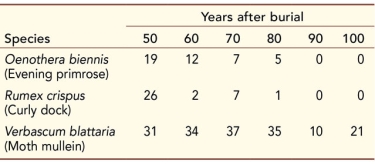Essay
Refer to the table.  In 1879, W.J.Beal began an experiment that he could not hope to finish in his lifetime.He prepared 20 lots of seeds for long-term storage.Each lot consisted of 50 seeds from each of 23 species.He mixed each lot of seeds with sand and placed the mixture in an uncapped bottle, then buried all the bottles in a sandy knoll.At 5- or 10-year intervals over the next century, biologists excavated a bottle and checked the viability of its contents.The table shows the number of germinating seeds (of the original 50) from three of the species in years 50-100 of this ongoing experiment.Calculate the percentage of the seeds that were still viable for these three species in years 50-100, and graph percent viable seeds as a function of years after burial.
In 1879, W.J.Beal began an experiment that he could not hope to finish in his lifetime.He prepared 20 lots of seeds for long-term storage.Each lot consisted of 50 seeds from each of 23 species.He mixed each lot of seeds with sand and placed the mixture in an uncapped bottle, then buried all the bottles in a sandy knoll.At 5- or 10-year intervals over the next century, biologists excavated a bottle and checked the viability of its contents.The table shows the number of germinating seeds (of the original 50) from three of the species in years 50-100 of this ongoing experiment.Calculate the percentage of the seeds that were still viable for these three species in years 50-100, and graph percent viable seeds as a function of years after burial.
Correct Answer:

Verified
Correct Answer:
Verified
Q154: All seed plants can be classified as<br>A)
Q155: Which of the following gymnosperms retain the
Q156: Despite the fact that only _ produce
Q157: You are sent to examine two adjacent
Q158: Refer to the figure. <img src="https://d2lvgg3v3hfg70.cloudfront.net/TB5650/.jpg" alt="Refer
Q160: The evolution of pollen has enabled seed
Q161: What are some examples of ways that
Q162: All of the following are floral organs
Q163: Compare the role of male and female
Q164: Rank gymnosperm groups in order from the